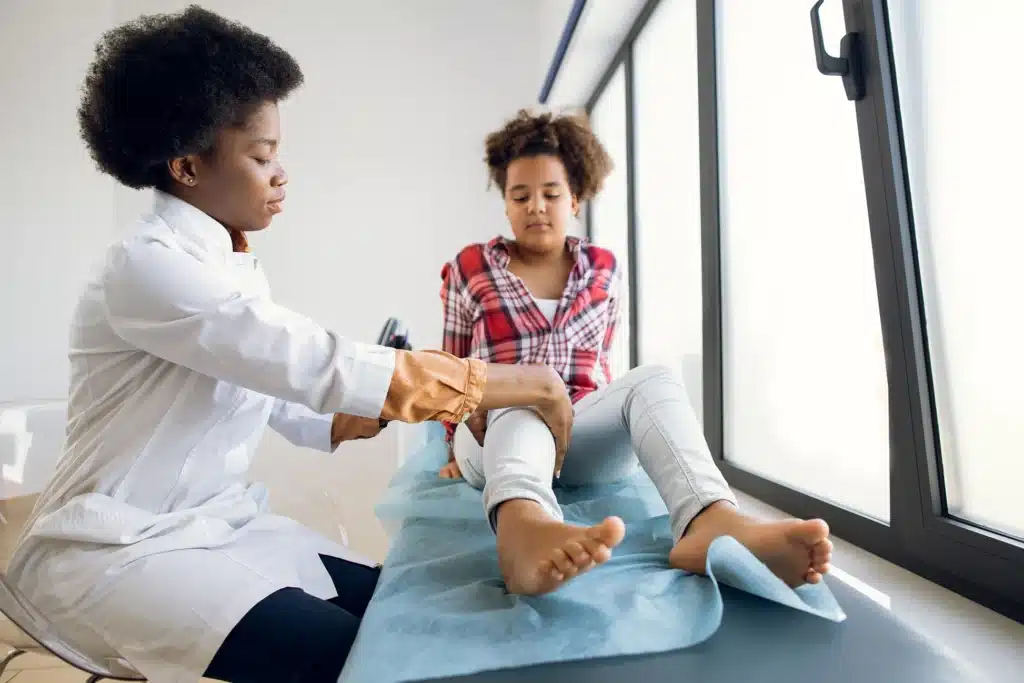
Table of Contents
ToggleWelcome to the intricate world of child-centric pain management.
Every parent knows the heartache of seeing their child in pain. Yet, what many don’t realize is that pain management for children is not just a smaller version of adult treatments.
In the bustling heart of Long Island, Long Island Neuroscience Specialists are at the forefront of this evolving science. Let’s dive in.
Children’s experiences of pain are fundamentally different from those of adults, and understanding this distinction is crucial for effective child-centric pain management.
These differences arise due to a multitude of factors—physiological, psychological, and developmental—that contribute to a child’s unique experience of pain.
Children’s medical concerns are varied and extensive. From acute conditions like fractures or burns to chronic illnesses such as cancer and hemophilia, the spectrum of diseases they face is wide-ranging. Each condition requires a different pain management approach.
For instance, the intermittent pain from a sickle cell crisis is not the same as the continuous pain experienced in certain types of cancer. Child-centric pain management acknowledges this diversity by customizing treatment plans to cater to each child’s unique needs.
Implementing effective child’s pain management is not just about medication. It also includes educating families, employing psychological strategies like distraction or relaxation techniques, and even using age-appropriate tools like games or storytelling to help children articulate their pain.
An interdisciplinary approach that involves pediatricians, nurses, psychologists, and parents is often the most effective.
Recognizing the distinct nature of children’s pain is the cornerstone for effective pain management in children.
A one-size-fits-all approach may be woefully inadequate; understanding the nuances of a child’s pain experience is key to their well-being and recovery.

Child-centric pain management places the child’s unique experience and needs at the forefront. Assessing pain in children can be more complex than in adults due to factors like developmental stage, cognitive abilities, and communication skills.
Here are some of the commonly used assessment techniques for child pain management:
These assessment techniques can be used individually or in combination, depending on the child’s condition and developmental stage. It’s essential to ensure that the chosen method is age-appropriate and suitable for the child’s cognitive and communication capabilities.

Child-centric pain management therapies focus on the unique needs and experiences of children, ensuring that the approach is tailored, effective, and, most importantly, child-friendly.
Here are some of the most effective ways we can help children cope with pain through these specialized treatments:
Physical Therapies:
This approach helps children recognize and change negative thought patterns and behaviors that may amplify their pain.
Teaching children to control physiological functions to help manage their pain. For example, they can learn to relax certain muscles to reduce headache intensity.
Techniques such as deep breathing, guided imagery, and progressive muscle relaxation can be particularly effective for managing pain in children.
Especially for post-operative pain, children can control their pain relief with prescribed limits using a PCA pump.
Traditional chinese treatments that can be adapted for children to help alleviate certain types of pain.
Helping children understand their pain can be empowering. Knowledge can reduce fear and anxiety associated with pain.
Providing children with age-appropriate books or interactive apps about pain and its management.
Engaging the family in pain management techniques such as creating a comfortable environment, positive reinforcement, or simply being there for emotional support can be extremely beneficial.
Child-centric pain therapies understand the intricacies of a child’s world. The core principle is to blend medical expertise with compassion, ensuring that children not only recover from their ailments but also retain their joy and innocence throughout the healing process.

Administering pain medications to children is a sensitive matter requiring special attention to dosage, timing, and potential side effects.
A Child-centric Pain Management approach focuses on tailoring medication plans specifically for the individual child, rather than simply scaling down adult doses.
This ensures that the child’s unique physiology and needs are taken into account, allowing for effective and safe pain relief.
Opioids like morphine, oxycodone, and fentanyl are powerful agents for pain relief but they come with risks such as respiratory depression, dependency, and other side effects.
When considering opioids for children, medical professionals weigh multiple factors including the child’s age, weight, overall health, and the type of pain they are experiencing.
The objective is to use the minimum effective dose for the shortest possible duration.
Sometimes, opioid medications are used in combination with other non-opioid analgesics to enhance pain relief while minimizing opioid-related side effects.
Narcotic medications are another category often used for more severe types of pain like post-surgical discomfort or acute pain from injuries.
While narcotics are effective, their potential for abuse and adverse effects like constipation or nausea cannot be overlooked. The key to using narcotic medications safely in children is stringent monitoring by healthcare providers.
Frequent assessments are essential to gauge the medication’s effectiveness and to adjust dosages or discontinue use if necessary.
Both categories of pain medications have the potential to significantly improve a child’s quality of life by alleviating pain effectively.
It’s imperative for caregivers and healthcare providers to engage in open communication about the child’s pain levels and any observed side effects, as this will inform ongoing treatment decisions.
Always consult with a pediatrician or a pediatric pain specialist when considering pain medication for children.
The groundbreaking approach of child-centric pain management is gaining momentum.
Navigating the complexities of children’s pain can be challenging, but by harnessing the right strategies and methodologies, we inch closer to a future where no child has to endure unnecessary pain.
If you’re a parent, caregiver, or just someone interested in ensuring our children’s well-being, dive deeper.
Explore the world of child-centric pain management with Long Island Neuroscience Specialists. Because every child deserves a pain-free future.
GET IN TOUCH +
285 Sills Road
Building 5-6, Suite E
East Patchogue, NY 11772
(631) 475-5511
184 N. Belle Mead Road
East Setauket, NY 11733
(631) 675-6226
GET IN TOUCH +
285 Sills Road
Building 5-6, Suite E
East Patchogue, NY 11772
(631) 475-5511
184 N. Belle Mead Road
East Setauket, NY 11733
(631) 675-6226
SUBSCRIBE TO OUR NEWSLETTER +
Send us a Google review. Click this link and let us know how we did!
Review us on Yelp too.